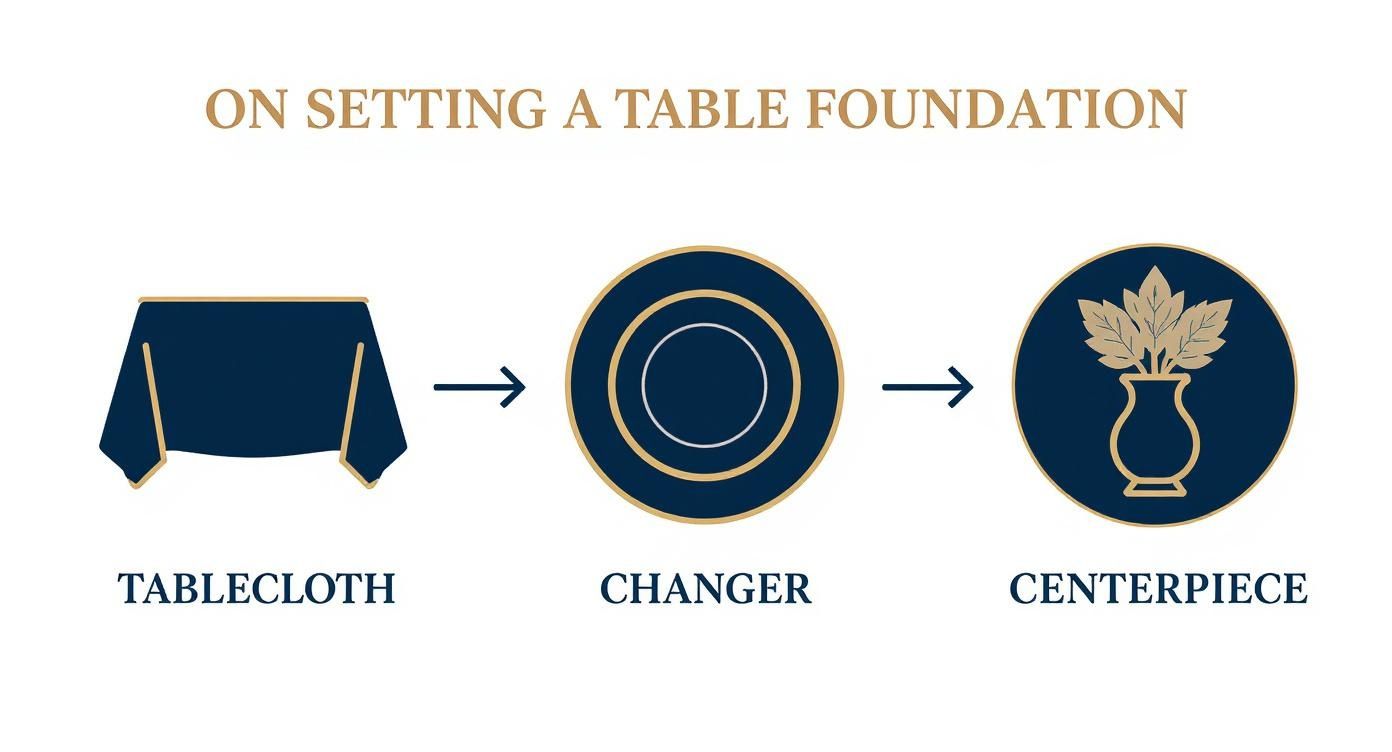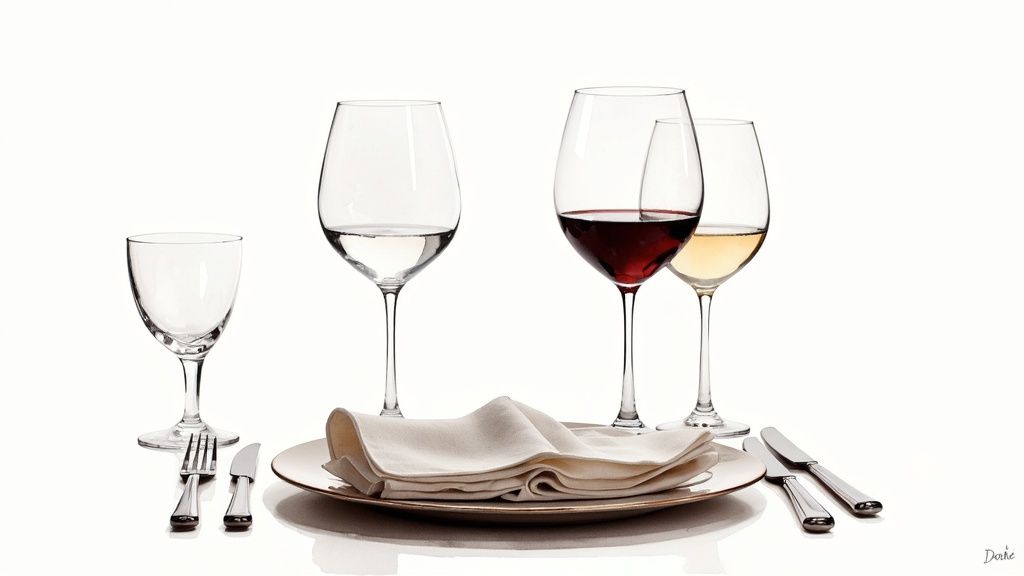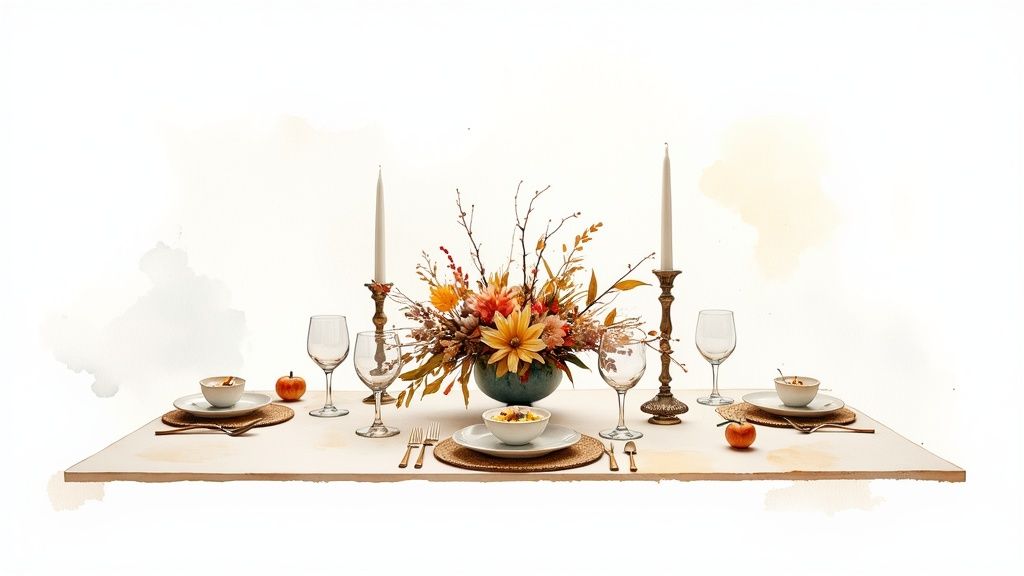How to Set a Formal Dining Table Like a Pro
Setting the stage for a memorable dinner party is an art form, and it all begins with the foundation. Long before you place a single fork, the canvas you create with your linens and charger plates sets the tone. It's the first thing your guests see, and it silently communicates the care and thought you've put into the evening.
The Foundation: Linens and Chargers
Think of your table as a blank canvas. The first strokes of paint are your linens, and they can completely transform the mood from casual to grand.
A crisp, freshly pressed tablecloth is the absolute cornerstone of a formal setting. I've found the best trick is to iron it directly on the table (with a protective pad underneath, of course!) to get a perfectly smooth, restaurant-quality finish. You're aiming for a drop of about 10-12 inches (25–30 cm) on all sides—just enough to look graceful without getting in anyone's lap.
With your linen in place, it's time for the charger plate. This isn't a plate for eating; it's an anchor for the entire place setting. It adds a layer of texture, color, and importance. Place it about an inch from the edge of the table, perfectly centered in front of each guest's chair. The charger stays put for the soup and salad courses and is typically removed just before the main dish arrives.
The real magic happens when your foundation elements work together. A smooth, satin-finish charger on a richly textured linen tablecloth creates a beautiful contrast that makes the entire setting feel intentional and thoughtfully designed.
These initial choices are where your personal style really starts to shine through.
Choosing Your Core Components
Getting these first pieces right is everything. They create the backdrop for your entire meal. Here's a quick rundown of what to consider:
- Tablecloth vs. Runner: A full tablecloth is the classic choice for ultimate formality. For a more contemporary feel that still shows off a beautiful wood or stone table, a runner can be a fantastic alternative.
- Charger Material: Don't be afraid to play with textures. Polished metal chargers bring a bit of glam, while beautiful ceramic or even rich wood can lend a warmer, more organic elegance.
- Color Palette: You can never go wrong with a timeless neutral like ivory, white, or soft gray. That said, a deep jewel-toned cloth for a holiday dinner or a soft pastel for a spring brunch can be absolutely stunning.
Before you start layering on plates and glassware, it's helpful to have a clear idea of what these foundational pieces do.
Here's a quick reference to get you started.
Quick Guide to Your Formal Table Foundation
| Component | Purpose | Key Placement Tip |
|---|---|---|
| Tablecloth/Runner | Creates the overall mood and color scheme of the table. | Ensure an even 10-12 inch drop on all sides for a balanced, elegant look. |
| Charger Plate | Acts as a decorative base and anchor for the dinnerware. | Center it one inch from the table's edge, directly in front of the chair. |
With these core elements in place, you've successfully built a sophisticated and inviting stage for the rest of your setting.
Ultimately, the goal is to create a strong visual base that feels both elegant and welcoming. If you're looking for new ideas or the perfect centerpiece table itself, browsing through different formal dining sets and tables is a great way to see how different styles and materials come together to create a truly polished look.
Arranging Cutlery and Dinnerware with Confidence
Staring at a jumble of forks, knives, and spoons can feel a bit intimidating, but there's a surprisingly simple logic to it all: the outside-in rule. You simply arrange the utensils in the order of the meal, starting from the outside and working your way in with each course. This isn't just about looking fancy; it’s a thoughtful way to guide your guests through the meal without a moment's hesitation.
This precise placement has a rich history, evolving from aristocratic traditions and social etiquette as new utensils (like the fork!) made their way to the table. If you're curious, you can read more about this fascinating evolution to see why these customs stuck around.
Think of your table setting as building layers. The tablecloth, charger, and centerpiece create the canvas for everything else.

As you can see, each piece builds on the last, creating a beautiful and functional foundation for the entire place setting.
Placing Your Forks, Knives, and Spoons
Let's get down to the specifics. Your dinner plate, or a charger if you're using one, is the anchor, sitting right in the center.
To the left of the plate:
- Dinner Fork: This is your largest fork, and it goes closest to the plate.
- Salad Fork: A slightly smaller fork, which sits to the left of the dinner fork.
To the right of the plate:
- Dinner Knife: This is placed directly to the right of the plate. Crucially, the blade should always face inward, pointing toward the plate.
- Soup Spoon: If soup is on the menu, this goes to the very right of the dinner knife.
This setup means that if your first course is soup, your guest instinctively reaches for the outermost utensil on their right—the soup spoon. No guesswork needed.
When in doubt, just remember this: "Forks on the left, knives and spoons on the right." It’s a simple trick that ensures you get it right every time and helps your guests feel completely at ease.
Don't Forget the Bread Plate
It’s an easy detail to miss, but the bread plate is essential for a truly formal setting. This small plate belongs to the upper left of the main place setting, floating just above the forks.
A small butter knife rests horizontally across the top of the bread plate. To really nail the look, place the handle on the right and have the blade face down, towards your guest. It’s these small, thoughtful touches that signal a host who knows their stuff.
Perfecting Your Glassware and Napkin Placement
There's something about the sparkle of glassware that really elevates a dining table. It catches the light and just screams elegance. But where you put those glasses isn't just for show—it's about making things comfortable and logical for your guests. The golden rule is to always place them in the upper right corner of the setting, directly above the knives.
Think of it as creating a gentle slope that angles away from your guest. The water goblet is always your starting point; it sits right above the tip of the main dinner knife. All other glasses, like those for wine, follow in a line to the right, arranged in the order they'll be used throughout the meal.
Arranging Your Glasses Correctly
For a standard dinner with both red and white wine, a three-glass setting is typical. The logic behind the layout is all about function and ease of reach.
- Water Goblet: This is the most-used glass, so it gets prime real estate. Place it directly above the dinner knife, making it the easiest one to grab.
- Red Wine Glass: This glass, which is usually a bit larger with a rounder bowl, goes to the right and slightly up from the water goblet.
- White Wine Glass: The smaller, more U-shaped white wine glass is then placed to the right and slightly below the red wine glass. This creates a neat little triangle or a clean diagonal line.
Here’s a great visual that shows exactly how this classic arrangement looks.

When you set them up this way, your guests can reach for their water all evening without having to perform an awkward maneuver over their other stemware.
The Finishing Touch with Napkins
Now for the final flourish: the napkin. This is where you can inject a bit of personality into the setting. You can find dozens of elaborate folds online, but in my experience, a simple, crisp fold often speaks with the most confidence. And for a truly formal affair, there's no substitute for a freshly ironed linen napkin.
My personal preference is a simple, elegant fold. A neatly folded rectangle placed directly on the charger plate or a sophisticated "pocket" fold holding a menu card adds a touch of class without being overly complicated.
Where you put the napkin also sends a subtle message. The traditional, always-correct spot is to the left of the forks. If you're going for a more modern, clean aesthetic, placing it right on top of the charger is a fantastic choice. You can also introduce a decorative napkin ring to add a bit of texture and tie the whole look together.
Weaving in Centerpieces and Personal Touches
Now for the fun part. With the plates, glasses, and silverware all in their proper places, it's time to bring the table to life with your own style. This is where you shift from the "rules" of table setting to the art of creating an atmosphere. The goal is to add warmth and character, transforming a technically correct table into an inviting and memorable one.
The Art of the Centerpiece
Your centerpiece is the star of the show, but it can't be a diva. I've seen it happen a hundred times: a stunningly tall floral arrangement that looks great in photos but completely blocks the view across the table. Guests end up playing peek-a-boo all night.
A good rule of thumb is to keep any centerpiece below 12 inches (30 cm). This ensures everyone can see each other and conversation flows naturally without a floral wall in the way.

Creating Ambiance and Making Guests Feel Special
Those little extra touches are what people remember most. They signal that you've thought about their experience from start to finish.
- Candlelight: Nothing creates instant ambiance quite like it. I love using a mix of heights—tall, elegant tapers paired with the gentle flicker of tea lights. The key is to make sure the flames are either well above or comfortably below eye level so nobody is staring into a flickering light.
- Place Cards: If you're hosting six or more people, place cards are a host's best friend. They prevent that awkward "where should I sit?" shuffle and give you the power to mix and match personalities for the best dinner conversations. Even a simple, beautifully handwritten card feels incredibly personal.
- Seasonal Accents: Think beyond a vase of flowers. A simple runner of small gourds and autumn leaves, a scattering of pinecones and holly for a winter gathering, or a vibrant bowl of lemons and limes in the summer can be just as beautiful. If you're looking for more creative inspiration, check out these fantastic dining table centerpiece ideas.
The best advice I can give is to make sure every final element feels intentional. From the lighting to a simple place card, each piece should contribute to a warm, welcoming environment, not just add clutter.
Ultimately, these finishing touches are your signature on the evening. They're a reflection of your personality and the care you’ve taken to create a special occasion for the people you love.
Why All the Fuss? A Quick Look at Formal Table Manners
Let's be honest, the elaborate rules of a formal table setting can feel a little stiff, maybe even arbitrary. But believe it or not, there’s a logic behind the madness, and it all comes from a pretty fascinating history. Once you grasp the "why," the whole process becomes less about following rules and more about creating a thoughtful experience for your guests.
Most of these traditions date back to the Victorian era, a time when dinner was less a meal and more a performance. The precise placement of every single fork, spoon, and knife was a signal. It showcased your social standing, your refinement, and your grasp of the intricate social dances of the time. Every piece had a job, and knowing which one to use was a mark of a well-bred individual.
From Victorian Parlors to Your Dining Room
While we've certainly loosened up since then, the core principles haven't changed much. Take the classic "outside-in" rule for using your silverware. It wasn't invented just to be tricky; it was a practical way to navigate a multi-course meal without having to guess which fork to grab next. It’s a simple system that emerged from a more complex time.
It's also fun to see how much has changed. Back in the Victorian days, it was actually considered rude to talk about the food you were eating—good or bad! You can dive deeper into some of these surprising Victorian table manners to see just how different things were. Thankfully, today, sharing our enjoyment of a great dish is a huge part of the fun.
When you realize these traditions were all designed to make the dining experience smooth and respectful for guests, setting the table stops feeling like a chore. Instead, it feels like you're taking part in a long history of hospitality.
Ultimately, that historical context brings it all home. Formal etiquette isn’t about being stuffy; it’s about making your guests feel comfortable, honored, and truly cared for.
A Few Common Questions on Formal Table Settings
Even when you feel you’ve got the basics down, certain menus can throw a wrench in the works. For instance, what do you do when serving oysters, which need a special utensil? It’s a classic question, and the answer is simple: the oyster fork is the only fork that sits on the right side of the plate. You’ll place it just outside the soup spoon.
Another frequent question I get is how to adjust the setting if you’re not serving a full five-course meal. The rule of thumb is to only set what your guests will need. If there's no soup course, leave off the soup spoon. Skipping the salad? Then there's no need for the salad fork or knife. The layout adapts to the meal.
Putting Your Guests at Ease
Remember, the whole point of a formal table is to create a sense of occasion and elegance, not to make your guests feel nervous. If you notice someone looks a bit uncertain, a good host knows just what to do. A quiet, friendly comment like, "We'll be starting with the soup, so feel free to use the spoon on the far right," can make all the difference. It’s about gentle guidance, not a pop quiz.
Let's be honest, in an era of grab-and-go meals, the art of formal dining isn't as widespread as it once was. In fact, some studies show that 35-40% of families often eat informally, sometimes not even at a dining table. You can read more about how modern dining habits have evolved on Wikipedia.com, and it really puts things into perspective. This shift is exactly why taking the time to set a beautiful table feels so special and memorable today.
The best hosts I know remember that etiquette is simply about making people feel comfortable and welcome. A perfectly set table is just an extension of that—a gesture of respect and care for your guests.
Ultimately, your own confidence and warmth as a host will do more to set a wonderful tone than any perfectly placed fork or spoon ever could.
At Fluent Trends, we believe every meal is an opportunity to create a special moment. We invite you to explore our curated collections of dinnerware, flatware, and serveware to bring that timeless elegance to your next gathering. Find the perfect pieces to tell your story at https://www.fluenttrends.com.